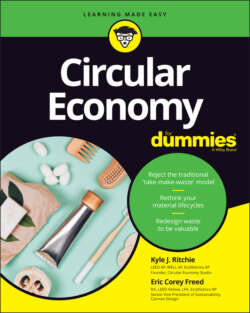Читать книгу Circular Economy For Dummies - Eric Corey Freed - Страница 35
Circular businesses, products, and clothing
ОглавлениеCreating a circular economy will require a massive shift in the way we manage and exchange materials and products. Businesses will need to collaborate with their partners to eliminate the need for raw-material extraction. Products will need to be designed to stay in use for longer periods, and the clothing industry — one of the most wasteful industries in operation — will need to make massive adjustments to eliminate waste. To top it all off, adjusting all these variables will require high levels of coordination and partnerships between all stakeholders involved.
Businesses are realizing that the way they operate and the impact they have on the environment greatly impacts their ability to maintain customers. Transitioning from a linear way of producing products to a circular one won’t be necessary only from an environmental perspective, but from a social and economic perspective as well. To minimize the negative impact on the environment, businesses will need to adjust the relationship they have with customers to maximize the value of the products they create. Rather than businesses viewing success as the number of products made per year, they will instead base their bottom line on the number of products kept in use per year. Though waste certainly creates a demand for companies to continue selling new products, eliminating waste doesn’t have to eliminate demand. By maintaining the ownership of a product rather than selling it, new business opportunities emerge in the world of maintenance and repair. Though eliminating waste minimizes the need for new products, it certainly increases the need to service existing products. The circular economy will demand that new business models focus on maintaining products rather than on making new products.
In addition to the relationship that businesses and customers have, the way products are made will also require a major shift. Accepting waste as a component of a product’s lifecycle encourages production processes where the sourcing of the required materials and durability of those materials remain as cheap as possible. Products are designed with planned obsolescence and minimal opportunities for repair for a reason: to encourage the purchasing of new products. However, by eliminating waste as a necessary step in a material lifecycle and shifting business services from product production to product maintenance, products can be designed to last for longer periods.
One major industry that will need a major overhaul is the fashion industry. Poor material usage, fast-fashion, and poor sharing-and-reuse networks act as only a handful of reasons that the fashion industry leads the way in terms of waste and pollution. The fashion industry’s transition from a linear production of clothes to a circular one will require these four major steps:
1 The industry will need to phase out fabrics and materials that aren’t fully recyclable — fabrics and materials that act as a major source of pollution.
2 Manufacturers and businesses will need to redesign how clothing is made and how it’s used. No longer will customers be required to purchase clothing, but opportunities for sharing will emerge under membership programs.
3 Clothing that is made will need to stay in use for longer periods. This translates to using more durable materials and offering sharing and buyback programs so that clothing that’s no longer being used has the potential for continued use.
4 The resources required to support the fashion industry — like cotton and hemp — will need to be regenerated to ensure that the demand for clothing can be met.
